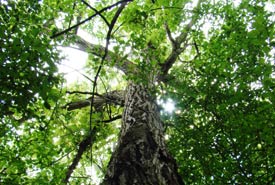
Butternut (Photo by NCC)
Butternut
Butternut trees are members of the walnut family and are one of two species of walnut native to Canada. They are widely distributed, though uncommon, across eastern Canada. On average, butternuts are short-lived trees, living up to 80 years of age.
What does it look like?
Butternuts are medium-sized deciduous trees, reaching up to 30 metres in height and up to 91 centimetres in diameter. The species has an open crown with yellowish-green compound leaves. The bark on older butternut trees has irregularly wide intersecting ridges with dark narrow fissures. Younger trees have smooth, grey bark.
Butternuts are often confused with black walnuts; however, butternuts have large terminal leaflets (leaves on the end of a compound leaf), hairy yellowish-orange twigs and egg-shaped fruits.
Where does the species grow?
Butternuts are native to North America, specifically central and eastern United States and southeastern Canada. In Canada, they are found in Ontario, Quebec and New Brunswick.
Although they can grow on a large variety of sites, butternuts grow best on loam (soil composed of clay and sand, which is ideal for growing plants) that is moist, rich and well-drained. Intolerant of shade, the species relies on sunny conditions for survival and can grow in small groups or alone.
What is this species' conservation status?
Butternut is assessed as endangered in Canada by the Committee on the Status of Endangered Wildlife in Canada, and is listed under the federal Species at Risk Act. There has been a significant decline in butternut populations due to the fungal disease butternut canker.
What is NCC doing to conserve habitat for this species?
The Nature Conservancy of Canada (NCC) protects habitat for butternut in several locations in New Brunswick, including the Lincoln Wetland near Fredericton, and along the Meduxnekeag River, near Woodstock. The Meduxnekeag River Valley is a priority area for NCC in Atlantic Canada. It is home to some of the last remaining mature Appalachian hardwood forest in the region, a forest type made up of white ash, basswood, ironwood and butternut.
NCC also currently protects the Quebec riverside property of Kettle Island, which contains a rare forest ecosystem with at-risk species like butternut.
In Ontario, NCC is working to restore butternut trees on the Freeman property in the Frontenac Arch.The Eastern Ontario sub-region currently manages and monitors a restoration project of 23 butternut trees as part of a mitigation project for the Ministry of Transportation. Since 2015, NCC staff have engaged in stewardship activities, including mapping and monitoring butternut conditions monthly (for example, recording height, diameter at root collar, number of stems, monthly precipitation and overall health). Maintenance activities on the property include fence repair, weeding, watering and installing tree guards.





